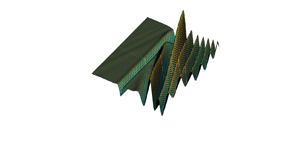Article contents
Two-dimensional response of a floating ice plate to a line load moving at variable speed
Published online by Cambridge University Press: 09 March 2022
Abstract

We significantly extend the results of Miles & Sneyd (J. Fluid Mech., vol. 497, 2003, pp. 435–439) for an accelerating line load on a floating ice plate in their simple linear mathematical model by proceeding to numerical calculations for the response due to a decelerating load. Our results show: (i) how the deflections produced by an impulsively started steadily moving line load begin to develop and eventually approach the well-known steady load-speed-dependent quasi-static and wave-like forms, including above the shallow water gravity wave speed where the shadow zone evolves; (ii) the singularity in the deflection predicted in the simple linear model when the load moves steadily is indeed avoided by a uniformly accelerating load, where the magnitude of the deflection continually increases and its maximum lags a little further behind as the load moves through the critical speed and beyond; (iii) there is also no singularity in the deflection due to a uniformly decelerating load, but whereas the response from a subcritical starting speed is preserved and travels with the load, the magnitude of the deflection may become quite large near a load starting from supercritical speed and approaching rest, which is attributed to constructive interference (reinforcement) as erstwhile trailing, predominantly gravity, waves catch up with the load. While this reinforcement poses no risk to Hercules transport aircraft landing on the thick sea ice at McMurdo Sound, it can account for the reported rapid sinking of the detached cockpit shortly after it came to rest in the 1974 Lockheed Electra aircraft crash in the Canadian Arctic.
Information
- Type
- JFM Papers
- Information
- Copyright
- © The Author(s), 2022. Published by Cambridge University Press
References
REFERENCES
- 8
- Cited by


